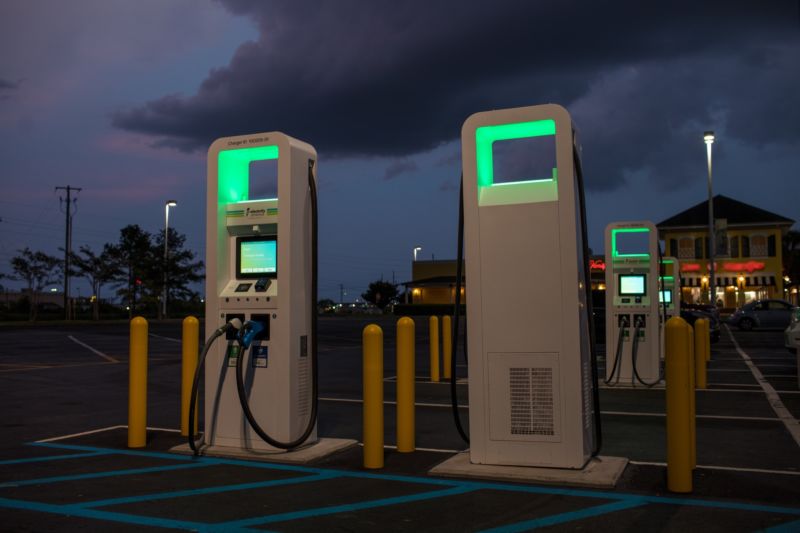About five years from now, a common complaint about electric vehicles—range anxiety—will be a thing of the past across much of the US.
Starting this year, the federal government will begin doling out $5 billion to states over five years to build a nationwide network of fast chargers. The plan initially focuses on the Interstate Highway System, directing states to build one charging station every 50 miles. Those stations must be capable of charging at least four EVs simultaneously at 150 kW.
Once states have completed the Interstate charging network, they’ll be able to apply for grants to fill in gaps elsewhere. The Joint Office of Energy and Transportation, a new agency formed to help the Transportation and Energy Departments administer the program, will allow case-by-case exceptions to the 50-mile requirement if, for example, no grid connection is available nearby.
Funding for the initial Interstate portion of the program will be allocated using a formula that mimics how federal highway grants are distributed. Starting in fiscal year 2022, $615 million will be available to build charging stations, and $300 million will be allocated to set up the Joint Office of Energy and Transportation. Ten percent of each year’s funding will go toward filling gaps in the network.
After the initial $5 billion program is launched, another $2.5 billion in discretionary grants will be available to build chargers in rural and underserved areas.
As part of their plans submitted to the federal government, states will need to ensure that the charging stations will be reliable—at least one charger per station needs to be working more than 97 percent of the time—and that they will limit their impact on the electric grid. States are also directed to design stations so they can be easily expanded and upgraded as demand grows and charging rates increase. The new program also encourages states to site chargers near travel centers, convenience stores, visitor centers, or restaurants.
To get credit for their Interstate build-out, states will have to install chargers that use the Combined Charging System, also known as CCS. With the exception of the Nissan Leaf, most models of EVs sold in the US can use this plug type. Though Teslas have their own plug type, the company is reportedly planning to offer an adapter that will allow at least some of its North American fleet to use CCS fast chargers. (It already offers that adapter in South Korea.)
The new program also prioritizes domestic production of chargers, which has already spurred some manufacturers to begin setting up operations in the US. Tritium, an Australian company that supplies some fast chargers to ChargePoint, said earlier this week that it would build a factory in Tennessee that can crank out 30,000 DC fast chargers per year. Siemens also plans to expand its US footprint so it can make up to 1 million chargers per year by 2025.
One area where the new program currently falls short concerns how people will pay for charging. Most non-Tesla EV owners have a number of apps on their phones (or fobs on their keychains) to give them access to different charging networks. It’s less than convenient.
“We’re taking a good look at this,” Secretary of Transportation Pete Buttigieg told Car and Driver. “Part of this program is going to be a shared standard. If we’re going to use taxpayers' dollars to help private actors put in charging stations, then of course we need to make sure the citizen is getting good value out of it. There may be any number of network benefits through loyalty programs. That’s fine,” he said, “but we’ve got to make sure… everybody can benefit.”
Putting a credit card reader on each charging station seems like a decent solution, though some networks already support the ISO 15118 standard, also known as "plug-and-charge." Drivers using compatible vehicles can simply plug in, and the charger and vehicle coordinate to handle both authentication and payment.
Buttigieg also said that the new Joint Office of Energy and Transportation will start looking into providing guidance on how to site and design chargers to facilitate vehicles towing trailers.
The new program represents a significant down payment on President Joe Biden’s pledge to create a network of 500,000 charging stations across the US by 2030. If that plan comes to fruition, it should help speed the country’s transition to EVs while slashing carbon emissions from transportation.



3175x175(CURRENT).thumb.jpg.b05acc060982b36f5891ba728e6d953c.jpg)

Recommended Comments
There are no comments to display.
Join the conversation
You can post now and register later. If you have an account, sign in now to post with your account.
Note: Your post will require moderator approval before it will be visible.